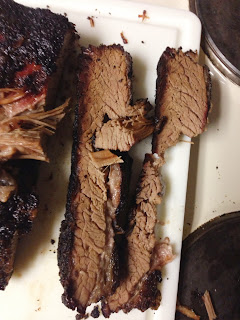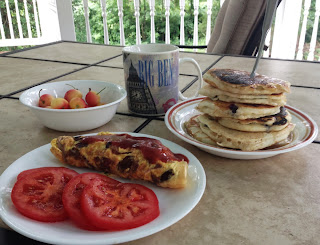Like many of us computer nerds, my mom's generally used hand-me-down computers. Her "desktop" machine-- which I put in quotes because my mom's "office" (most of us would say it looks a good bit like a "living room" or a "den") has never had a desk in it-- anyhow, her "desktop" is my seven year old Macbook Pro. When she saw my Macbook Air a few years back, though, she realized that it would be so much nicer for travel (which is why I have it) and would work quite well for taking on a cruise-- so she didn't wait for me to have one to hand down and bought herself a brand new machine. (Which is good, because she'd still be waiting.)
But even though it's a much newer machine, it's a bit small for every-day use-- oddly enough, I think it's a "laptop" that wants to be used on a desk so you can get your eyeballs closer to it. So even though my old Macbook Pro is starting to develop some overheating issues, it won't make a good stand-in for the desktop. So now she's looking at buying a new 15" laptop for the house.
This means that my mom, who up 'til recently used almost entirely hand-me-downs for computing, will have both a newer "desktop" and a newer travel machine than I have.
That in itself is strange to me, but that's only what lead me to the weird part. Sure, part of the reason for this is that her use cases no longer look like mine-- I've no use in my life for a full-sized laptop, so the machine on my desk in my office is an actual desktop, and she's got nowhere to put an actual desktop (or I'd've shipped her a keyboard, mouse, and monitor to attach to the Air already).
But most of it-- and the strange part-- is that I've had no real reasons to upgrade, so I've got nothing to hand down anyhow.
It wasn't all that long ago that a nerd like me couldn't even contemplate sitting in front of a four-year-old machine and not be itching to upgrade. Software designers keep coming up with new ideas, and those ideas need more processor power. They take more memory. A machine from a few years ago may not have been able to handle more than 4 gigabytes of memory. They didn't have multi-core processors with virtualization extensions to make virtual machines run smoothly.
Now, part of that is that I'm not interested in speed for speed's sake. I don't care what the benchmark says. I tend to group computational problems into four categories: "finishes pretty much instantly", "get coffee", "go out for lunch", and "runs overnight." It's rare-- even back when I was upgrading computers every year or two-- that a hardware upgrade pushes a problem from one category to the next faster one. What pushes me to upgrade is when things that were in the "finishes pretty much instantly" category start to get into a realm between finishing instantly and wandering upstairs to pour another mug of joe.
Sure, I've upgraded a few parts along the way-- and they're pretty hefty upgrades, but it wasn't long ago that the CPU simply wouldn't have been able to keep up. I had usually replaced every component in a computer, with the possible exception of the chassis and power supply, by the time two years had come around. Twice that, and I still feel no need to upgrade.
I can only assume that software engineers aren't holding up their end of the arrangement.
 |
| ...and maybe some cookies while we're at it... |
Sure, I've upgraded a few parts along the way-- and they're pretty hefty upgrades, but it wasn't long ago that the CPU simply wouldn't have been able to keep up. I had usually replaced every component in a computer, with the possible exception of the chassis and power supply, by the time two years had come around. Twice that, and I still feel no need to upgrade.
I can only assume that software engineers aren't holding up their end of the arrangement.






















